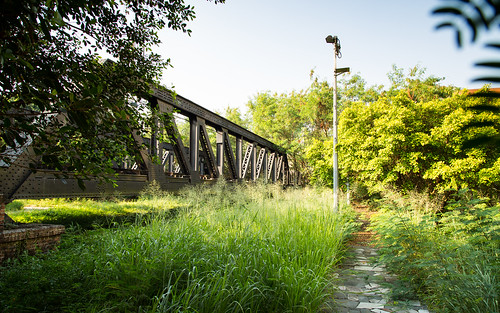This is the story of the Lo Wo railway bridge, which has carried trains from Hong Kong into China since 1910.
Work on the first railway bridge at Lo Wu commenced in 1906 and was completed in 1909, opening in 1910 together with the British Section of Kowloon-Canton Railway, but did not form a connection through to Canton until the opening of the Chinese Section to traffic in 1911. The three span bridge had a central 100 foot (30 metre) steel truss, flanked by a pair of 20 foot (6 metre) steel girder spans at either end.
The bridge was heavily defended in World War II, after the Imperial Japanese Army occupied Shenzhen and Guangzhou after landing in Daya Bay in October 1938.
Through train services being stopped, and barbed wire crossing the bridge.
After the attack on Pearl Harbor in the early morning of December 8, 1941 and the Japanese declaration of war against the British Empire, the Royal Engineers were instructed to immediately demolish the Lo Wu Bridge in order to slow down the Japanese invasion, but with little effect.
Reaching Kowloon a few days later. During the Japanese occupation of Hong Kong, the railway bridge was rebuilt, but destroyed by the Imperial Japanese Army following their surrender in 1945.
After the British retook control of Hong Kong, a temporary bailey bridge was built at Lo Wu.
But only for the use of passengers crossing on foot.
By 1950 a permanent steel bridge had been built, 32 metres long and 12 metres wide.
For the use of trains.
But passengers still needed to cross the bridge on foot, thanks to the suspension of through passenger train services to the mainland in October 1949, after the Communists took control after the Chinese Civil War.
The first improvement to be made to the crossing was the enclosure of the steel trusses in December 1950 in an attempt to protect passengers from thieves.
In December, at the request of the Police Department, which provided the necessary funds, the Railway Border Bridge was totally enclosed with steel plates in order to afford protection to foot passengers who were robbed by gangs operating from Chinese Territory. The thieves climbed up on to the under-girders of the bridge and slashed baggage with razor blades while others snatched wrist watches and jewellery openly. On one occasion when the British Police endeavoured to stop them they were pelted with stones, bottles and nightsoil.
A larger station at Lo Wu was opened in 1952 to handle the growth in passengers crossing the border, with further expansion occurring in 1954 and 1957, and in 1962 the curved roof was added over the bridge to shelter crossing passengers.
In 1966 the station was rebuilt a second time, as cross-border traffic continued to grow, with further expansion continuing through the 1970s.
A big change came in April 1979, when the Guangzhou-Kowloon through train service was restored.
And the usage of the railway bridge by pedestrians ended in 1981, with the completion of a pedestrian-only bridge.
However expansion of Lo Wu station continued, with electrification of the railway completed in 1982, and a new six story railway station and border crossing complex in 1986.
And the final change came in 2004, when works to widen the Shenzhen River saw the need to replace the second-generation bridge with a longer span.
The second-generation bridge was retained for preservation, being relocated to a site on Hong Kong bank of the river.

Drainage Services Department photo
Allowing the current bridge to be slid into place.

深圳新时速 photo, via Trainnets.com
Today’s bridge is 44 meters long, 20 meters wide and 11 meters high.
Footnote: on second-generation bridge today
The completion date of the second-generation bridge is a little hazy – some sources say it was completed in 1957, but that doesn’t fit the photos I found online which show it being in place during the early 1950s.
Despite being nominally ‘preserved’, the second-generation bridge is being reclaimed by nature.
Inaccessible to the public.
Further reading
History:
- Lo Wu in 70 years, China Daily
- Lo Wu Bridge at Wikipedia (Chinese-language)
- To rule a big country, you need to watch small bridges, China Youth Daily (Chinese-language)
- Lo Wu Station, HK Rail Fandom (Chinese-language)
Special events:
- Special event at the Lo Wu bridge to make the 100th Anniversary of the Chinese Communist Party (Chinese-language)
- Feel the power of reform! “Four Histories” at Luohu Bridge (Chinese-language)
- Chinese border guards mark “Four Histories” at the Lo Wu Bridge (Chinese-language)
Bridge relocation:
- Conservation of Lo Wu Railway Bridge, Drainage Services Department
- Lo Wu Bridge to be preserved as a monument media release
- Shenzhen River Regulation Project Stage III – Environmental Impact Assessment
- Luohu Railway Bridge (Chinese-language)
- Centuries-old Luohu Bridge was turned into an antique bridge yesterday and moved to the Hong Kong side, Sohu News (Chinese-language)
- The overall relocation of Luohu Bridge in Shenzhen will last forever as a commemoration, Sina News (Chinese-language)
- Luohu Bridge, a century-old bridge, was “decommissioned” and moved 17 meters in 15 minutes, Sohu News (Chinese-language)
















